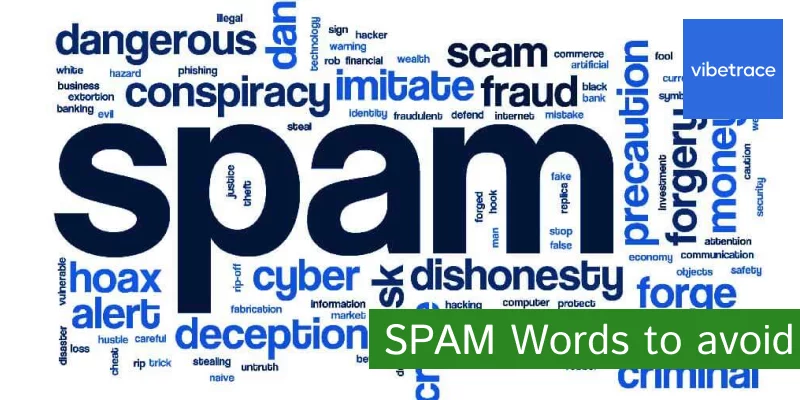Imagine it’s 1978, and you’re at the steps of a brave new world – one filled with computers. Your name’s Gary Thuerk, and you have an irresistible offer to make.
You embark on a bold marketing campaign and send an email blast to several hundred users of ARPANET.
You’re hoping for profits, but your actions also mark the birth of a phenomenon we know as spam.
That’s not fiction – it’s the first example of an unsolicited email marketing campaign.
The response is almost universally negative, and no similar experiments occurred for decades after Thuerk’s email blast.
That’s why spam became a real problem in the early 2000s. Today, spam filters constantly evolve and become more and more sophisticated. But spammers learn as well. The sophisticated spam filters affect honest entrepreneurs and retailers the most.
But since email marketing is one of the most profitable communication channels today, you can’t afford to land in the spam. That’s the worst that can happen to a carefully crafted campaign.
For that reason, we created a detailed article filled with examples and tips to help you rise above the noise and connect with your audience in a meaningful way. And dropping spam words from your email is the first step.
But first, let’s take a closer look at what spam words are!
Definition of Spam Words
Since some very common words happen to be bad for your emails, the idea behind spam words evolved over the years. Today you’ll find them as spam trigger words – words and phrases that email providers have flagged as malicious.
If your email provider detects such words, your email will most likely end up in the spam folder. But the good news is that spam trigger words are not the only reason for getting your emails flagged as spam. On the contrary, there are plenty of other factors like lack of personalization, poor design and technical execution, shady formatting and punctuation, and so on.
But the first challenge is always getting your subject line to work. To ensure it doesn’t trip spam filters, focus on avoiding spam trigger words as much as possible. Of course, promoting your current sales and discounts isn’t impossible, but you must do it with care. Below, we’ll explore why!
Why Avoiding Using Spam Words is Important?
Landing in your customers’ inbox isn’t the only reason to be careful with spam trigger words. Here’s why it matters so much for businesses using this communication channel:
- Improving Email Reputation & Performance – the more relevant and genuine your emails, the better their chances of reaching the inbox. If you abuse spam words and constantly trigger existing filters, deliverability rates will drop. That, on the one hand, might get your domain flagged as a source of spam. If you underestimate spam word management, you’ll face dropping open rates, as well, since your emails won’t be visible or will get immediately trashed. Reduced visibility naturally leads to worse ROI.
- Building Trustworthy Customer Relationships – using some of the more outrageous, cheap-trick spam words might hurt the brand by destroying your existing credibility. By avoiding them, you demonstrate to customers that you’re not all about the cash grab but also try to deliver additional value, including through personalization, when sending emails. That’s crucial for successful email communication, especially for B2B businesses.
Spam trigger words affect the sender’s reputation and seriously impact the email marketing campaign’s performance. By avoiding them, you can maintain a good brand image.
Are you wondering where to start? Below, you can discover examples of some of the worst words that you must drop from your subject lines today.
Common Spam Words
| TYPE | WORD |
| Exaggeration | 100% |
| #1 | |
| Best price | |
| Miracle | |
| Risk-free | |
| Free access | |
| Get paid | |
| Make money | |
| Satisfaction guaranteed | |
| Prize | |
| Misleading & Unethical | Cancel at any time |
| No catch | |
| No obligation | |
| This isn’t a scam | |
| We hate spam | |
| Hidden charges | |
| No cost | |
| No disappointment | |
| No questions asked | |
| Lose weight | |
| Urgency | Act now |
| Information you requested | |
| Limited time | |
| Sign up free | |
| Will not believe your eyes | |
| Order now | |
| Urgent | |
| This won’t last | |
| Take action | |
| You have been selected | |
| Jargon | All new |
| Bonus | |
| Cash | |
| Deal | |
| Luxury | |
| Certified | |
| Debt | |
| Opt-in | |
| Unlimited | |
| Trial |
Spam trigger words and phrases that can hurt your subject lines encompass several broad categories. These include:
A. Offensive Language
Slurs, insults, and derogatory terms must never appear in your subject line. Explicit and inappropriate language is offensive and will immediately trigger spam filters.
Slang might also trip the filters and hurt your email deliverability. Keep that more informal language for social media accounts, and never act offensive, even if it’s for attention.
B. All-Caps Phrases
The most sophisticated spam filters can detect all-caps in your subject line and email body. That might send your email straight to the spam folder.

And if, for some reason, it’s not enough to be considered spam, many people from your audience might consider it rude. And you don’t want them to think you’re rude or lack basic etiquette.
Want to be up to date with Marketing?
Subscribe to our Retail CX newsletter!

Stay connected with what’s really important to optimize your digital revenues.
By clicking the button, you accept our Terms & Conditions. Also you will need to confirm your email address.
C. Clickbait
We’ve all received clickbait emails with subject lines like “I’m sorry I lied to you,” “I should’ve been honest with this,” “This happens once in a lifetime,” and so on.
Clickbait techniques might work for mass media, but in email marketing, it will hurt deliverability and brand reputation. Especially since clickbait lines are often irrelevant or misleading – customers will quickly abandon your brand, even if you find a way to avoid spam filters through clever phrasing.
D. Inappropriate Emojis
We’ve discussed emojis for email marketing at length – check out the dedicated emojis in email subject lines article for an in-depth look into the topic. Don’t forget to avoid emojis with an inappropriate connotation, explicit gestures, and violent and discriminatory images. Also, don’t forget to use them moderately!
E. Quick Money Promises
Get-rich-quick schemes and promises are outdated. Claims for instant cash, easy money-making, and overnight financial freedom harm both you and your target audience. Avoid them at all costs if you want to keep reaching a relevant audience with meaningful communication that can build trust and convert.
You must take mindful steps toward removing spam trigger words and elements from your subject lines and email body. Below, we’ve gathered several valuable tips you can integrate into your email marketing strategy today to boost tomorrow’s email marketing performance.
We also encourage you to use a preferred subject line tester. Such tools can help you determine the quality of subject lines the moment you come up with them. They will even identify words that will negatively impact the health of that bite-sized piece of copy.
Tips to Avoid Using Spam Words
Remember, that whether an email ends up in the spam folder depends on a mix of factors, like the specific context of the email and the intention of the launched campaign.
Make it a priority not to mislead customers and to stay professional (even when you use puns or wordplay in your subject lines).
Here’s how to support email marketing efforts and deliver value, not just promotional materials, that customers will be happy to see in their inboxes:
A. Use Professional Language
The lists with spam trigger words are constantly updated. That’s why writing successful subject lines is one of the most time-heavy tasks for email marketers. You must craft a subject line that will grab the readers’, not the spam filters’ attention.
When it comes to using professional language, it doesn’t mean you need to act painfully formal. Stick to the tone of voice your audience is used to, the one associated with your brand, without unnecessary exaggeration or slang:
- Choose words and phrases that keep the tone civil and convey your brand’s voice;
- Always be polite and respectful;
- Don’t try to confuse your audience with colloquial expressions;
- Address people by using the appropriate titles and names they’ve shared.
Additionally, pay attention to the way people have subscribed to your emails. Someone might’ve submitted their first name without a capital letter. Make sure to clean your data and edit any entry that can benefit from that before sending emails.
B. Avoid Non-Specific Phrases
Be specific when sending emails. That’s a direct line of communication, and you want to avoid ambiguity if you don’t want to alienate subscribers. Words and phrases like “amazing”, “incredible offer”, “once-in-a-lifetime chance” don’t add value to the copy. Instead:
- Provide specific details;
- Keep it straight to the point;
- Stay relevant to your customers’ interests;
- Explain in simple terms your value proposition.
Otherwise, you risk becoming irrelevant and losing credibility. That will boost the number of unsubscribed users and will tank the quality of your emails. As a result, they might end up in the spam folder.
C. Be Mindful of Formatting
As mentioned, keep strange formatting to a minimum. That includes font choices, using lots of bold or italics, and shouting at your subscribers in ALL-CAPS. Any excessive formatting will send your email straight to the spam folder.
Instead, make sure your email is easy to read, the information is well-organized, and capitalization and excessive punctuation are minimal. Here, we must mention emojis as part of the formatting – use only relevant emojis and in moderation.
D. Review Content Before Sending
Every modern email platform allows you to preview your emails and send tests. Take advantage of that. Apart from rereading your email and subject line before launching the campaign, send it to your colleagues. They might catch something you missed in your tone or how you address customers.
Additionally, always double-check for grammar and spelling. Make sure you fix or remove any broken images and links, and cut anything unnecessary that bloats the body but fails to create value.
If you take these actions, you’ll be one step closer to your customers’ inboxes and one step further from the spam folder. Be considerate of subscribers and what they care about. And don’t miss the opportunity to personalize emails.
To Sum Up
Spam trigger words are email marketers’ greatest enemy. Even the smallest thing can trigger some providers’ spam filters and doom your email to the lands of shadows.
And being mindful of your subject lines is not enough. Spam trigger words can appear in them, but also in your body, even CTAs and signatures, and that’s a cause for concern.
Be mindful of how you craft your email copy. Always use the best practices in email marketing if you want to avoid spam filters. The hard truth is that blacklists keep growing, and new words are featured constantly.
For a comprehensive service, don’t hesitate to contact the VibeTrace experts or explore our email marketing knowledge base to learn more about email etiquette.
Check our subject line topics for inspiration and expert guidance on crafting quality subject lines to help kickstart successful email marketing efforts!
Other links you might want to have checked:
https://instantly.ai/blog/spam-trigger-words#the-ultimate-list-of-700-spam-trigger-words
https://blog.hubspot.com/blog/tabid/6307/bid/30684/the-ultimate-list-of-email-spam-trigger-words.aspx
https://www.softwarepundit.com/email-marketing/email-spam-words#nogo
https://www.activecampaign.com/blog/spam-words
https://www.mailmodo.com/guides/spam-words/
https://www.businessnewsdaily.com/16325-email-spam-trigger-words.html
https://ortto.com/learn/email-spam-trigger-words/
https://www.sendx.io/help/list-of-spam-trigger-words
https://mailmeteor.com/blog/spam-words
